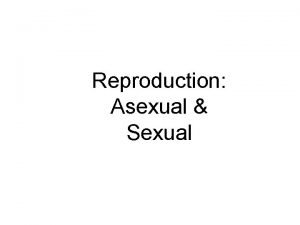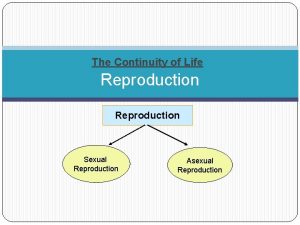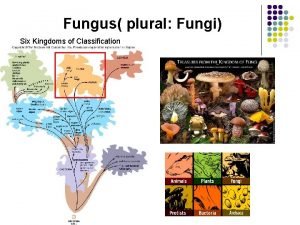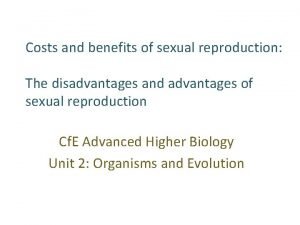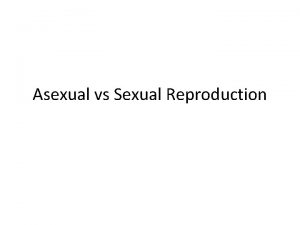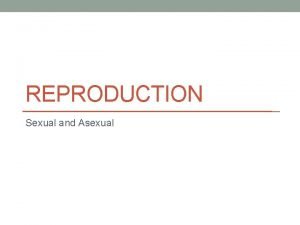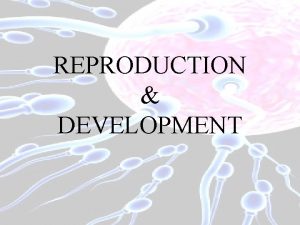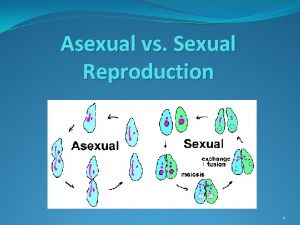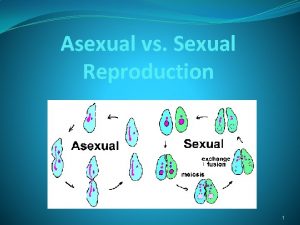Sexual Asexual Reproduction Science 9 Sexual reproduction requires














- Slides: 14

Sexual & Asexual Reproduction Science 9

Sexual reproduction requires both a female and male, and involves the fusion of two gametes to reproduce an offspring. Some unicellular organisms and plant may reproduce asexually, but most fish and mammals use sexual reproduction to reproduce offspring.

THE 2 TYPES OF SEXUAL REPRODUCTION There are two types of sexual reproduction – Syngamy and Conjugation. 1. Syngamy This type of sexual reproduction is the permanent fusion of two gametes in order to create a zygote. This is called fertilization in humans. 2. Conjugation This is temporary fusion of two haploid gametes to exchange male and female cells using a cytoplasmic bridge.

THE TOP ADVANTAGES OF SEXUAL REPRODUCTION 1. Sexual reproduction permits variation, which is evolution’s fundamental element. It creates species, which can adapt to harsh environmental changes, and cannot be wiped out by a single disease. But, this reproduction process requires significant amount of energy in part of organisms finding a mate. This reproduction process is not suited to organisms stuck in one place or isolated. 2. The offspring’s genetics are unique as they are formed from crossing over. It is favorable when the environment is not favorable or stable for the species. This is a slower rate of reproduction, but has faster evolution.

THE TOP ADVANTAGES OF SEXUAL REPRODUCTION 3. Also, sexual reproduction allows for fast removal of bad mutations, which can conjoin two beneficial mutations. The offspring has better adaptation to host parasite arms race. 4. Offspring can be dispersed widely in different places from their parents. 5. Sexual reproduction allows for multiple numbers of offspring. The offspring can evolve at a fast rate.

THE TOP 2 DISADVANTAGES OF SEXUAL REPRODUCTION 1. Sexual reproduction requires two parents. The parents must expend energy in order to find; court or identify, and copulate with their mate. If conditions are stable, the genetic recombination may be counter-reproductive. Also, sexual reproduction is less efficient at passing on genes. The favorable genes combination may be broken. 2. Sexual reproduction also requires more time to produce offspring. Animals may take months before they can produce offspring. In plants, it may take years before they bear fruits, which is why asexual reproduction is most preferred by breeders.

ASEXUAL REPRODUCTION There are organisms like the komodo dragons and corals that can reproduce asexually or sexually. Asexual reproduction is a process that does not require the interaction between two different genders of the same species. The cells divide through mitosis – the process wherein each chromosome is copied before the nucleus divides. Each chromosome receives identical genetic information.

ASEXUAL REPRODUCTION Asexual reproductions are perfect for organisms in place or unable to find mates. This reproduction process is well suited for organisms thriving in a stable environment. However, this reproduction process does not produce varying offspring, which means that the entire group can be wiped out by a single disease, or when the environment becomes unstable. Generally, sexual reproduction is suited for animals, fish, and other types of plants while asexual reproduction is limited to plants only.

Asexual Reproduction: Binary Fission An organism splits directly into two equal sized offspring Each with identical genetic information as the parent

Asexual Reproduction: Budding The offspring begins as a small outgrowth from the parent Eventually it breaks off and becomes an organism of its own

Asexual Reproduction: Fragmentation A new organism is formed when a part that breaks off from the parent Example - starfish

Asexual Reproduction: Spore formation The parent organism undergoes cell division to produce smaller, identical cells These cells are called spores and are housed within the parent

Asexual Reproduction: Vegetative reproduction A section of the plant grows to form a new plant

Why are some organisms hermaphrodites? What does this mean and what are the advantages? You have both male and female reproductive parts Species that do not move a lot or come into contact with other members of their species (example worms, tomato plants) Discuss further using your text.
 The disadvantages of sexual reproduction
The disadvantages of sexual reproduction Asexualk
Asexualk Venn diagram asexual vs sexual reproduction
Venn diagram asexual vs sexual reproduction Synapsis and crossing over
Synapsis and crossing over Asexual vs sexual reproduction
Asexual vs sexual reproduction Chromosome number of animals
Chromosome number of animals Venn diagram sexual and asexual
Venn diagram sexual and asexual Sexual or asexual reproduction
Sexual or asexual reproduction Branching hyphae
Branching hyphae Sexual or asexual reproduction
Sexual or asexual reproduction Sexual or asexual reproduction
Sexual or asexual reproduction Reproduction
Reproduction Asexual or sexual reproduction
Asexual or sexual reproduction Asexual reproduction cell division
Asexual reproduction cell division Example for sexual reproduction
Example for sexual reproduction




